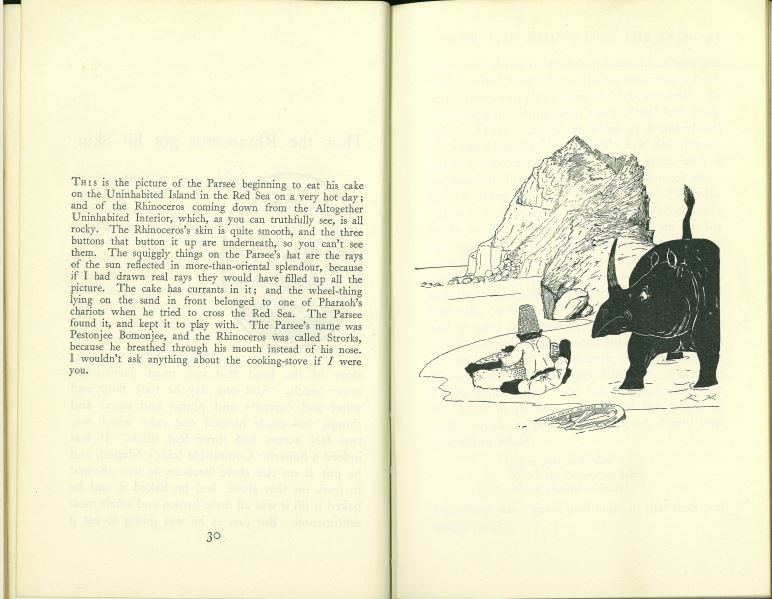Wonder how the world-famous author Rudyard Kipling, a Parsi artist and a Rhinoceros are connected? Look at the portrait of a Parsi artist, Pestonjee Bomanjee (1851-1938) with his long white beard, working on a canvas and beside it is a facsimile of a story written by Rudyard Kipling, on ‘How the Rhinoceros got his Wrinkly Skin’. This is a must for all English literature buffs and all those who have for long inhabited the mesmerising world of Rudyard Kipling.
Article By: Firoza Punthakey Mistree

Bomanjee was a natural artist and his time was spent largely in the big airy studio on the grounds of the school, making the various clay models of flora and fauna, griffons and fantastic creatures, required to decorate the many neo-Gothic style, buildings that were being built on Hornby Road (now Dadabhai Naoroji Road) a mile and a half away from the art school.
Harry Ricketts, the biographer of Rudyard Kipling notes, that Rudyard remembered ‘vast green spaces and wonderful walks through coconut woods on the edge of the sea where the Parsees waded in and prayed to the rising sun.’ This was perhaps one of Kipling’s earliest memories of the Parsis.
Bomanjee, then the only Parsi student at the JJ School of Art, was well acquainted with Rudyard whom he described as an impish child, who would frequently wander across the compound to the School of Art where Bomanjee and other artists were creating models and would pelt them with clay pellets, before being scolded and banished to his home by his father.
These and other encounters with Bomanjee, inspired Rudyard to weave a fantastical tale centred on the artist titled ‘How the Rhinoceros got his Wrinkly Skin’. It was one of the bedtime stories Rudyard narrated to his daughter Josephine.
Kipling weaves this story around a Parsi who lived ‘on an uninhabited island on the shores of the Red Sea… and from whose hat, the rays of the sun were reflected in more-than-oriental splendour’. This was Kipling’s imaginary description of Bomanjee. The story is about a Rhinoceros who rudely invaded the home of a Parsi and chased him out and of how the beast ate up a freshly baked cake and the way the clever Parsi took revenge on the beast. The curious lesson to be learned from this strange adventure was put into verse by Kipling — ‘Them that takes cakes/ Which the Parsee-man bakes/ Makes dreadful mistakes’.
In a note in the 1955 edition of Just so Stories For Little Children, Kipling confirmed, ‘This is the Parsee Pestonjee Bomonjee sitting in his palm tree… wearing a new more-than-Oriental-Splendour hat of the sort that Parsees wear…’. Perhaps a reference to the shiny lacquered hats Parsis in Bombay wore on a regular basis.
The small portrait of Bomanjee by Ardeshir Pestonji, which is nothing like Kipling’s fantastical drawings of him, depicts the artist precariously balanced, with his foot raised on a stool, intensely mixing paints on a wooden palette. Bomanjee eventually took up painting under John Griffiths who taught him the rigours of European portrait painting, and he was among the first group of Indian artists trained by European teachers who worked on reproducing the Ajanta frescoes.
Firoza Mistree,writes about Rudyard Kipling & Pestonjee Bomanjee. #EverlastingFlame https://t.co/ogFfaor0sc pic.twitter.com/Xq0VWeO6aV
— National Museum (@NMnewdelhi) May 4, 2016

